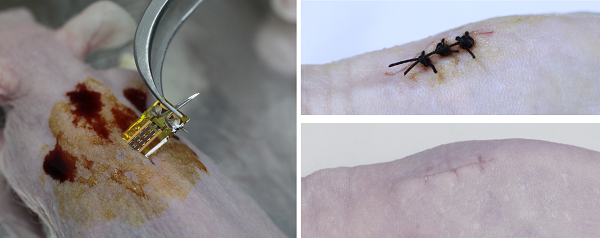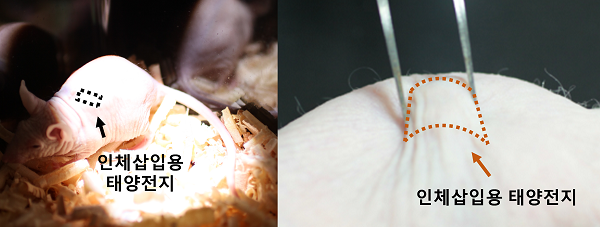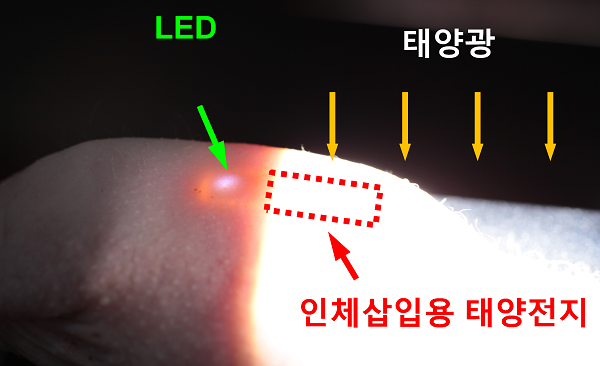Media Center
A multimedia mosaic of moments at GIST
GIST Excellence
[Press Release] GIST Professor Jongho Lee has created a new approach for powering implantable medical devices by using subdermal flexible solar arrays
- 엘리스 리
- REG_DATE : 2016.05.27
- HIT : 927
GIST Professor Jongho Lee has created a new approach for powering
implantable medical devices by using subdermal flexible solar arrays

Figure 1 (from left): 1. An image demonstrating the flexibility of the IPV device, 2). A schematic illustration of a potential application of the IPV device to power implantable electronic devices, such as a pacemaker,
and 3). Professor Jongho Lee.
Advances in medical technology have made tremendous strides in recent years, especially with regards to implantable medical devices that help to monitor and sustain human life. Improvements in miniaturization along with increased technical capabilities have spurred a revolution in the design and development of new implantable medical devices to help improve people"s quality of life. From insertable cardiac monitors, pacemakers, spinal cord stimulators, and glucose monitors, more and more people have become dependent upon implantable medical devices, especially as the overall population continues to age and gray.
Although the design and development of implantable devices continue to expand, their main limitation is having a reliable and sufficient power source to ensure their functionality. Batteries are the most common solution to provide power, but this is not an ideal solution for implantable medical devices—such as a pacemaker—because a major invasive operation is required to replace the batteries.
To find a better solution, GIST Professor Jongho Lee of the School of Mechanical Engineering has led an international research team to develop a new and novel approach for powering in vivo medical devices by using available photovoltic and energy storage technologies to create an implantable photovoltic (IPV) device to generate enough power to operate currently available implants.
The IPV device uses ultra-thin flexible solar cells that are transfer-assembled and encapsulated within a biocompatible material so that it can be placed subdermally through a relatively simple dermatological procedure, and it is capable of generating electricity by utilizing light that is transmitted through the skin.

Figure 2. An optical image during surgical procedure to implant the IPV device under the back skin
of a hairless mouse, and images of the surgical scar after stitching (upper) and after healing (lower).
When tested in live hairless mouse models, the IPV devices generated approximately 647 μW of direct current power, which is significantly higher than previously reported alternative approaches for in vivo power generation. Another advantage of the IPV device over other approaches is its scalability: Power output can be easily adjusted by changing interconnections or by adding more solar microcells depending on the energy requirements of the implants.

Figure 3. Relative scale of the IPV device implanted in a live hairless
mouse model, and an image of the subdermal IPV device being pinched.

Figure 4. An example of fully implanted LED that is powered by an IPV device with a
rechargeable battery in a live hairless mouse to confirm the feasibility of the concept.
Theoretically, under ideal circumstances, a standard pacemaker that uses 282 μAh per day can operate indefinitely (instead of being surgically replaced every 8 years) if it can be recharged by an IPV device that is exposed to 126 minutes of proper illumination per day.
Their paper entitled "Subdermal Flexible Solar Cell Arrays for Powering Medical Electronic Implants" was published online on May 3, 2016, by Advanced Healthcare Materials and was authored by Kwangsun Song, Jung Hyun Han, Taehoon Lim, Namyun Kim, Sungho Shin, Juho Kim, Hyuck Choo, Sungho Jeong, Yong-Chul Kim, Zhong Lin Wang, and Jongho Lee.
Professor Jungho Lee said, "Our research has demonstrated the feasibility of using implantable photovoltic devices to power electrical devices within the human body, which has been the main impediment to further development. Now that we have addressed this problem with a new approach that is superior to other approaches that are currently being researched, I expect to see an increase in the development and market for implantable electronic devices."